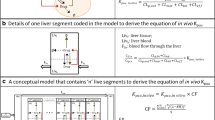Abstract
We examined data from our previous studies in which we not only delivered perfusate containing tracer concentrations of [14C]phenacetin and its metabolite [3H]acetaminophen under constant perfusate flow (10 ml/ min/ liver) into the rat liver preparation just once, but also recirculated fresh reservoir perfusate containing a tracer dose of [14C]phenacetin through the same rat liver preparation. From the single-pass studies, estimates of fm, the fractional rate of conversion for [14C]phenacetin to form [14C]acetaminophen, and F(M.P), the apparent availability of [14C]acetaminophen, were obtained by determining the concentrations of [14C]acetaminophen in the perfusate before and after incubation with Glusulase. These estimates were fm=0.871±0.16 and F(M.P)=0.43±0.10. These and the steady-state clearance values of phenacetin (9.1±0.8ml/min) and acetaminophen (6.7±0.7ml/min) from the single-pass studies were used to predict the concentrations of [14C]acetaminophen in the reservoir perfusate on recirculation of [14C]phenacetin. We found that the sequential first-pass elimination of the metabolite must be considered when the metabolite is highly extracted by the liver. If we had neglected to take this into account, the fractional rate of conversion of a precursor to form a metabolite and the rate of formation of the metabolite would have been underestimated by the factor F(M.P).
Similar content being viewed by others
References
M. Rowland and S. Riegelman. Pharmacokinetics of acetylsalicylic acid and salicylic acid after intravenous administration in man.J. Pharm. Sci. 57:1313–1319 (1978).
S. A. Kaplan, M. Lewis, M. A. Schwartz, E. Postma, S. Cotler, C. W. Abruzzo, T. L. Lee, and R. E. Weinfield. Pharmacokinetic model for chlordiazepoxide HCL in the dog.J. Pharm. Sci. 59:1549–1574 (1970).
S. A. Kaplan, M. L. Jack, S. Cotler, and K. Alexander. Utilization of area under the curve to elucidate the disposition of an extensively biotransformed drug.J. Pharmacokin. Biopharm. 1:201–216 (1973).
K. S. Pang and M. Rowland. Hepatic clearnace of drugs. III. Additional experimental evidence supporting the “well-stirred” model, using metabolite (MEGX) generated from lidocaine under varying hepatic blood flow rates and linear conditions in the perfused rat liverin situ preparation.J. Pharmacokin. Biopharm. 5:681–699 (1977).
K. S. Pang and J. R. Gillette. Kinetics of metabolite formation and elimination in the perfused rat liver preparation: Differences between the elimination of preformed acetaminophen and acetaminophen formed from phenacetin.J. Pharmacol. Exp. Ther. 207:178–194 (1978).
K. S. Pang and M. Rowland. Theoretical considerations of a “well-stirred” model and a “parallel tube” model. I. Influence of hepatic blood flow, plasma and blood cell binding, and the hepatocellular enzymatic activity in hepatic drug clearance.J. Pharmacokin. Biopharm. 5:625–653 (1977).
M. Rowland, L. Z. Benet, and G. G. Graham. Clearance concepts in pharmacokinetics.J. Pharmacokin. Biopharm. 1:123–136 (1973).
K. S. Pang and J. R. Gillette. Theoretical relationships between area under the curve and route of administration of drugs and their precursor for evaluating sites and pathways of metabolism.J. Pharm. Sci. 67:703–704 (1978).
G. Knott and D. Reece.MLAB: An Online Modeling Laboratory, 7th ed., Division of Computer Research and Technology, National Institutes of Health, Bethesda, Md., July 1977.
G. Levy. Pharmacokinetics of salicylic acid elimination in man.J. Pharm. Sci. 54:959–967 (1965).
S. H. Wan and S. Riegelman. Renal contribution to overall metabolism of drugs. II. Biotransformation of salicylic acid to salicyluric acid.J. Pharm. Sci. 61:1284–1287 (1972).
H. G. Boxenbaum and S. Riegelman. Pharmacokinetics of isoniazid and some metabolites in man.J. Pharmacokin. Biopharm. 4:287–324 (1976).
R. E. Notari. Alteration of pharmacokinetics through structural modification. In E. B. Roche (ed.),Design of Biopharmaceutical Properties Through Prodrugs and Analogs, American Pharmaceutical Associations, Washington, D.C., 1977, p. 68.
Author information
Authors and Affiliations
Rights and permissions
About this article
Cite this article
Pang, K.S., Gillette, J.R. Sequential first-pass elimination of a metabolite derived from a precursor. Journal of Pharmacokinetics and Biopharmaceutics 7, 275–290 (1979). https://doi.org/10.1007/BF01060018
Received:
Revised:
Published:
Issue Date:
DOI: https://doi.org/10.1007/BF01060018




